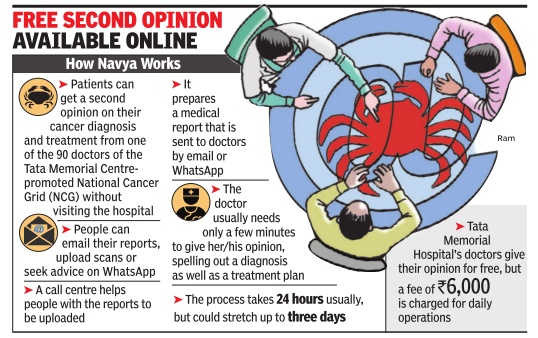Tata Memorial Hospital
This is a collection of articles archived for the excellence of their content. |
Contents |
Cancer treatment
Radiation therapy, ultra-high/ 2025
Eshan Kalyanikar, June 28, 2025: The Times of India
Mumbai : The treatment chamber’s walls had to be leadshielded, the next few rooms vacated and several other strict safety measures put in place before two highly radioactive injections were given at a gap of just 15 seconds to a 17-year-old with stage 4 neuroblastoma at the Tata Memorial Centre’s ACTREC facility in Kharghar recently. It marked the first time such a high-dose procedure had been attempted in India, requiring extensive planning over three months, safety checks and full-scale mock drills.
Treatment for neuroblastoma, a type of cancer mostly associated with children, will change significantly and can be provided for Rs 4-5 lakh. At the moment, treating a neuroblastoma requires a multimodality approach, including anti-GD2 immunotherapy, and costs around Rs 75 lakh, said oncologists.
Patient stable after dose, outcome hinges on 2-yr recovery window
The patient was treated on May 5 and discharged in 5 days. This week, he was considered out of danger — for now. The outcome of the treatment will be determined over the next two years depending on if the patient has cured or had a relapse. “We were coordinating with Sloan Kettering Cancer Center in New York. There were three meetings with them, as they have performed over 100 such procedures before. Our confidence increased after learning that our hospital was already extensively equipped,” said Dr Archi Agrawal, head of the nuclear medicine department who spearheaded the pioneering treatment and was one of the two doctors who administered the injections.
A patient remains highly radioactive after the therapy and even bodily fluids and excretions pose a risk of nuclear exposure to others. To prevent this, urine and stool were collected and stored in special containment systems — ‘delay-decay tanks’ — designed to hold radioactive waste for several days until the radiation decays to safe levels before disposal. From lead-shielded walls and a high-isolation treatment room to a long-term nuclear biomedical waste holding system, doctors said the procedure was only possible because the Advanced Centre for Treatment, Research and Education in Cancer (ACTREC) had much of the required infrastructure inplace. The treatment, called 131ImIBG, is a type of radiotherapy in which a radioactive form of iodine is attached to a molecule (MIBG) that is absorbed by neuroblastoma cells. This allows targeted radiation to the tumour while sparing most healthy tissues.
“Until now, only a 300-millicurie dose of this therapy was administered to patients,” said TMC director Sudeep Gupta. Most hospitals typically administer 200 millicuries. “We aimed to deliver 800 millicuries: four times the usual dose and the highest ever given in India,” said Dr Venkatesh Rangarajan from the department of nuclear medicine.
The permissions had to be obtained from the Atomic Energy Regulatory Board. The hospital recalled that two AERB officials were sent to ACTREC to monitor the procedure. Dr Agarwal emphasised that there was no room for error and that the safety of the patient and everyone in the hospital was the top priority. “We managed it because the patient and their family were highly cooperative, and isolation protocols were strictly followed. Everything, from food to medical assessments, had to be managed through the door, from a distance,” she said, adding that she would have risked radiation exposure herself to rush to the patient had he experienced an emergency hypertensive episode. “That was a risk, but thankfully, it did not occur,” she said.
Other departments involved include departments of pediatric oncology, the bone marrow transplant unit, and the transfusion medicine department. Dr Navin Khatry of haematology department said that the cure rate for this treatment is 30%, with a relapse typically occurring within two to three years. He added, “The condition impacts pediatric patients. This treatment will be only given to patients who have had a relapse. We will be doing clinical trials before moving ahead with this therapy for others.”
Initiatives, services
Tata Memorial's online service comes as a boon, June 10, 2017: The Times of India

A low-cost online service run by Tata Memorial Hospital doctors has helped 10,799 patients from 22 countries get a second opinion on their cancer diagnosis and a treatment plan without visiting the hospital in three years.
A survey of about a 1,000 of them showed that as much as 78% of them went on to receive treatment according to the expert's opinion. The doctors presented their experiment with Navya, the online service, at the prestigious American Society of Clinical Oncology meeting on June 5.
“There is a scarcity of on cologists in the world. Patients in non-urban areas have poor access to evidence-based treatment decision and worse outcomes. In India, there are 1,600 oncologists for 1.8 million patients and the lack of expertise translates into sub-optimal and expensive treatment decisions,“ said Dr C S Pramesh of the cancer hospital.
The survey revealed that 72.3% interviewed patients shared the expert opinion with their treating oncologists. And, 78% of the patients got treatment based on expert's recommendations.
The demand-supply gap in cancer treatment is obvious from the fact that the Parel hos pital gets thousands of patients every day from across the country . To plug this gap, the hospital joined hands with Navya in 2014 to provide online second opinion so that patients and their families don't have to travel thousands of kilometres for an opinion. A fee of Rs 6,000 is charged for using the service. The doctors don't charge for an opinion, the fee is for daily operations.
At present, 90 doctors from the Department of Atomic Energy-supported National Cancer Grid (NCG) are experts on the Navya panel. Around 100 hospitals that provide cancer treatment across the country are part of the grid.